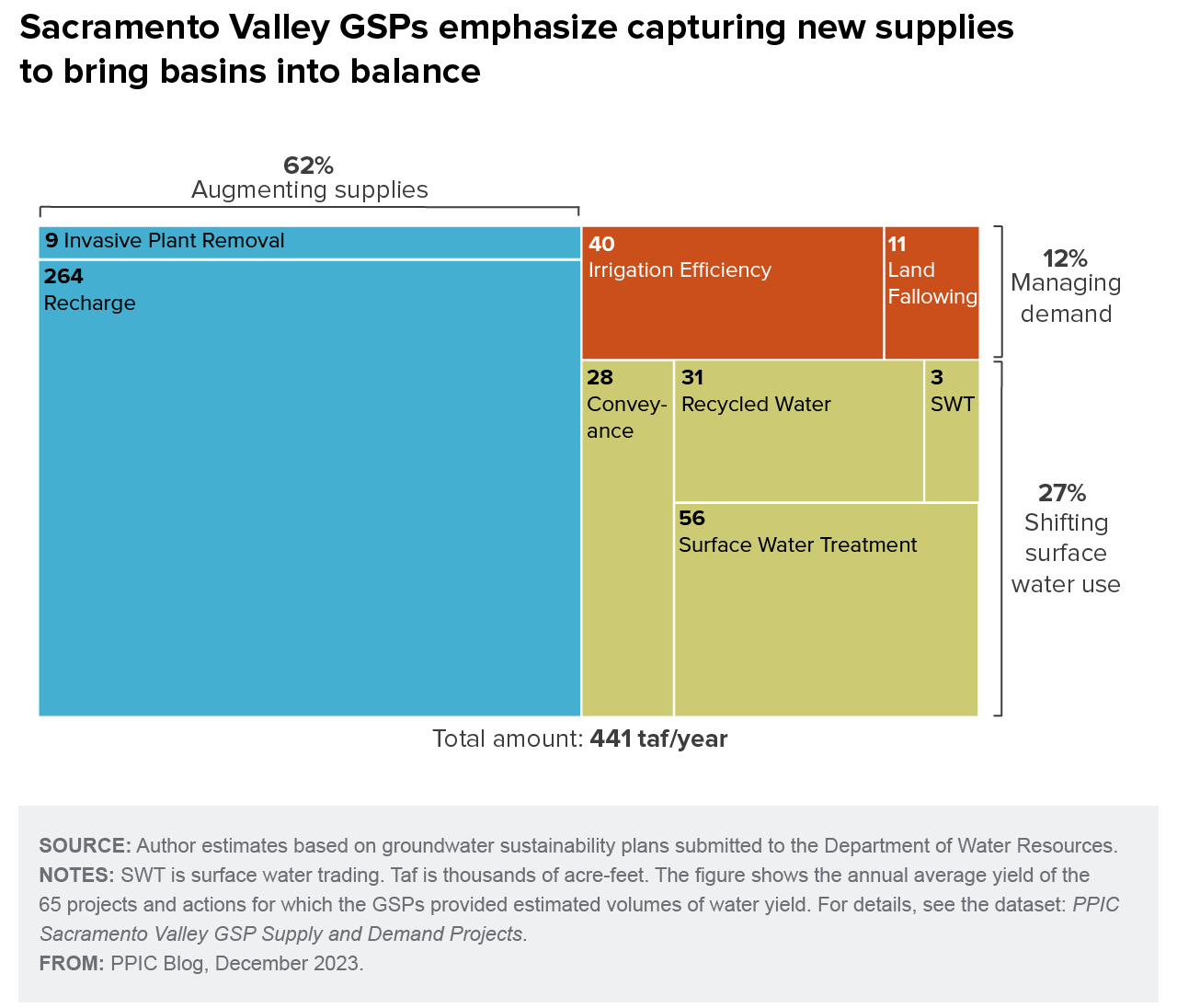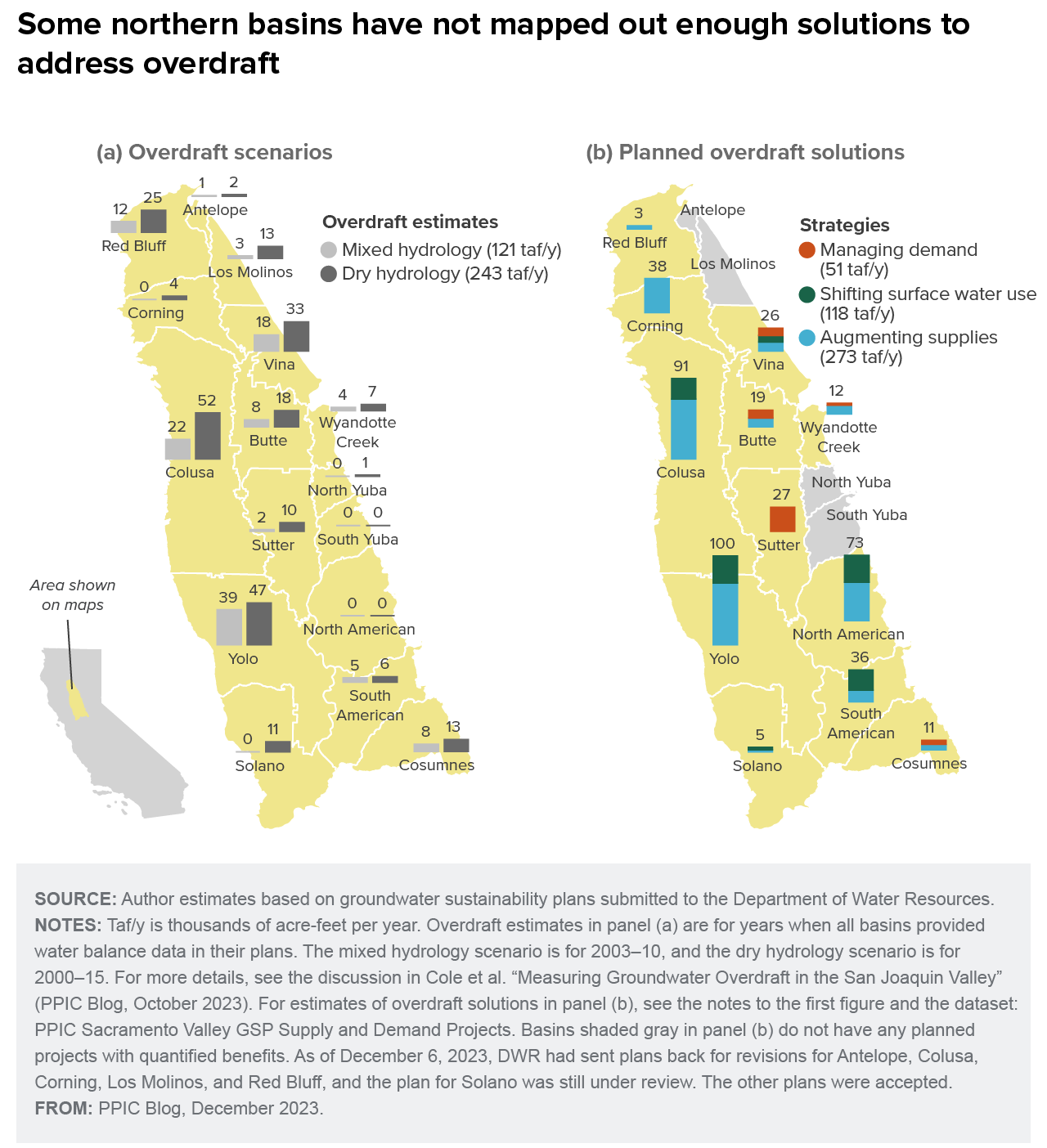BLOG
December 15th, 2023
Via the Public Policy Institute of California, a report on ways to address groundwater overdraft in the Sacramento Valley:
Although the Sacramento Valley has relatively abundant surface water supplies, groundwater is also an important resource for many of its communities and farms. In fact, one-third of the valley’s farmland depends entirely on groundwater, and more than half (60%) of all farmland relies at least in part on groundwater. The Sustainable Groundwater Management Act (SGMA) now requires local water users to steward this resource and prevent undesirable results of overdraft, or excess pumping.
In a previous blog post, we examined how groundwater sustainability plans (GSPs) in the region’s 16 basins assess overdraft. While the problem is far less acute than in the drier San Joaquin Valley to the south, many basins have issues to address. In this post, we explore how the plans envisage bringing their basins into balance. An accompanying dataset provides details for each basin.
How will the Sacramento Valley GSPs mitigate overdraft?
The math for bringing basins into long-term balance is relatively simple: it requires expanding water supplies, reducing water demands, or a combination of these two approaches. Plans must present quantitative estimates of the anticipated volume of water that would be added or saved (also known as “yield”) from these efforts.
The figure below shows a region-wide breakdown of how the plans propose to reduce overdraft, and the annual average yield. The supply solutions are broken into two groups: projects that would augment overall supplies in the region, and projects that would shift more groundwater users to surface water without necessarily increasing overall supplies. As in the San Joaquin Valley, the plans place a much greater emphasis on boosting supplies than on reducing demand:
- Augmenting supplies. These projects account for more than half the total volume (62%), and they focus largely on replenishing groundwater basins with additional surface water in wetter years. Methods include in-lieu recharge (where basins get a natural boost when pumpers use surface flows instead of groundwater) and on-farm recharge (where growers allow temporary flooding of their fields to recharge the basin).
- Shifting supplies. About a quarter of the total (27%) would come from getting groundwater users to switch to surface water on a more regular basis. Strategies include expanding surface water treatment facilities—so more communities can use surface water for their drinking water supplies—and expanding the use of recycled wastewater water by both communities and farms. Projects also include conveyance improvements to extend the use of surface water to more areas.
- Managing demand. Just a small fraction (12%) would come from reducing water use, mainly from improvements in the efficiency of irrigation systems.
Do the numbers add up?
At first glance, the region’s planned supply and demand efforts would amply address overdraft. In total, the projects would provide 441,000 acre-feet per year of water solutions—nearly four times more than the regional overdraft under mixed hydrology (with a typical share of wet and dry years), and nearly double the overdraft for a relatively dry period.
But a closer look at the data by basin reveals some gaps. As the figure below shows, most basins facing overdraft—and even some that are in balance—anticipate potential solutions that could more than cover their problems, even under drier conditions. But for several northern basins—Red Bluff, Antelope Valley, and Los Molinos—the plans do not identify enough actions to address overdraft under either hydrologic scenario. Although the volumes of overdraft in these basins are relatively small, it’s noteworthy that the Department of Water Resources (DWR) has deemed plans in all three basins (along with Corning and Colusa) “incomplete” and in need of additional work.
Could the proposed projects provide all the water identified in the plans? In the San Joaquin Valley—where plans had to address a much higher level of overdraft—we found that many plans were counting on using the same water for their supply projects, so that every drop of new water was being double- or even triple-counted.
In the Sacramento Valley, several factors make this problem less likely. First, the volumes needed to fill groundwater deficits are much smaller. Second, the region’s relatively wetter conditions will likely reduce competition for water across different projects. And third, water users did a better job of coordinating: each Sacramento Valley basin has a single plan, whereas most San Joaquin Valley basins have multiple plans.
It’s nevertheless possible that some of the supply projects envisaged (particularly those that shift surface water to new users) will reduce water currently available for other purposes—something a basin-by-basin planning approach can miss. Given this region’s role as an exporter of water, the impacts could be local or occur elsewhere in the state. There’s also a risk that planned efforts to improve irrigation system efficiency only reduce the water applied to fields, not the amount that crops actually consume. As plans in the San Joaquin Valley have generally recognized, it’s the latter—the “net” water use or evapotranspiration—that matters for long-term groundwater balances.
Other groundwater management priorities
Ending overdraft is not the only task facing Sacramento Valley’s groundwater sustainability agencies. Sustainability plans fundamentally aim to avoid significant and unreasonable results from groundwater use—such as impacts to wells, groundwater-dependent ecosystems, and land subsidence. Some impacts can occur even in basins that are in generally good shape, particularly during extended droughts.
Recent work by The Nature Conservancy suggests that many of the region’s plans may need to strengthen groundwater monitoring systems to protect both wells and ecosystems, and better address the consequences of the chronic lowering of groundwater levels. In its recent review, DWR also raised concerns about the adequacy of proposed strategies to mitigate well failure and avoid other harmful impacts of pumping during dry periods. Yet while there’s still work to do, water users in the Sacramento Valley appear poised to succeed at meeting these challenges.



